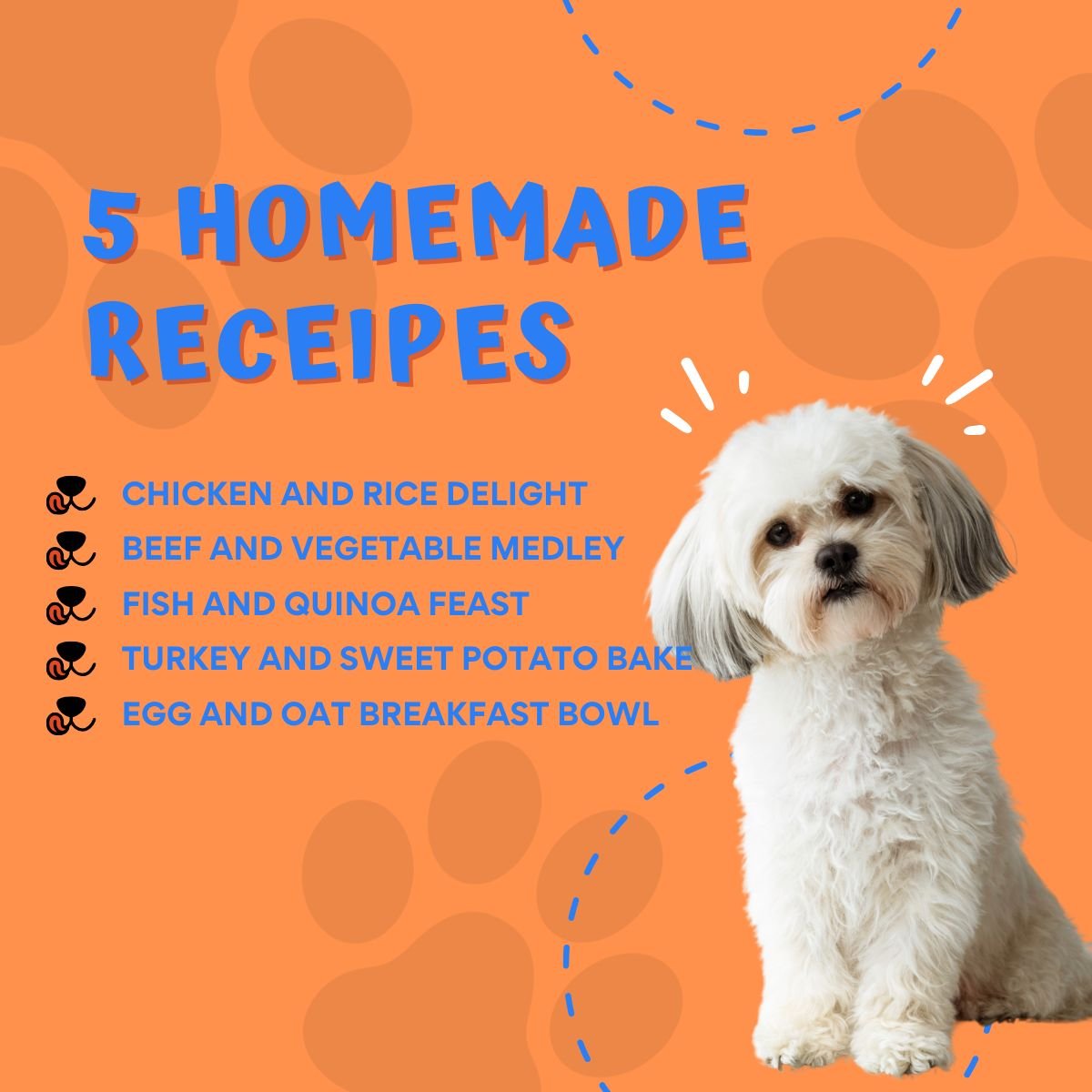Have you ever thought about preparing homemade dog food for your furry friend? Many pet owners are turning to homemade meals to ensure their dogs receive optimal nutrition. By crafting meals at home, you have complete control over the ingredients, allowing you to select high-quality, wholesome options tailored to your dog’s needs. Dive into these five delicious and balanced homemade dog food recipes that will make your pup’s tail wag with delight!
Disclosure: PetzVibes.com is a free online platform that provides valuable content and comparison services. To keep this resource free, we may earn advertising compensation or affiliate marketing commissions from the partners featured in this blog.
🐾 Key Takeaway
-
Complete Ingredient Control: Crafting homemade dog food allows you to select high-quality, wholesome ingredients, ensuring your dog receives optimal nutrition without unwanted additives.
-
Tailored Nutrition: Homemade meals can be customized to meet your dog’s dietary needs, including age, breed, activity level, and health conditions.
-
Improved Digestive Health: Homemade diets can alleviate gastrointestinal issues for dogs with sensitive stomachs by avoiding common allergens and incorporating easily digestible ingredients.
-
Enhanced Bonding: Preparing meals for your dog fosters a deeper bond, as you’re directly contributing to their health and happiness.
-
Consultation is Key: Before transitioning to a homemade diet, consult with a veterinarian or canine nutritionist to ensure all nutritional requirements are met.
Why Choose Homemade Dog Food?
Preparing homemade dog food offers numerous benefits for you and your canine companion. By crafting meals at home, you gain complete control over the ingredients, ensuring your dog receives high-quality, nutritious food tailored to their needs.
Benefits of Homemade Dog Food
-
Ingredient Control: Homemade dog food allows you to select wholesome ingredients, avoiding fillers, artificial additives, and potential allergens commonly found in commercial pet foods.
-
Freshness and Quality: By choosing fresh meats, vegetables, and grains, you can provide meals that are not only nutritious but also more palatable for your dog.
-
Customized Nutrition: Every dog is unique. Homemade meals enable you to tailor the diet to your dog’s age, weight, activity level, and health conditions, ensuring optimal nutrition.
-
Digestive Health: Homemade diets can particularly benefit dogs with sensitive stomachs. Eliminating common irritants and focusing on easily digestible ingredients can help alleviate gastrointestinal issues. For more information on feeding dogs with sensitive stomachs, visit our guide: Best Food for Dogs with Sensitive Stomachs.
Embracing homemade dog food enhances your dog’s health and strengthens the bond between you and your pet. Your care and attention to each meal will also benefit your dog.
Preparing homemade dog food can be fulfilling and beneficial to you and your canine companion. Here are other compelling reasons to consider transitioning to homemade meals for your dog.
Control Over Ingredients
When you prepare your dog’s food at home, you have complete oversight of every ingredient in their meals. This control is crucial, especially if your dog has food allergies, intolerances, or sensitivities. By selecting each component, you can ensure that your dog’s dietary needs are met without including fillers, artificial preservatives, or harmful additives commonly found in some commercial dog foods.
Freshness and Quality
Homemade meals allow you to choose fresh, high-quality ingredients, such as organic meats and vegetables free from preservatives. This freshness can enhance the nutritional value of the food, potentially leading to improved health, increased energy levels, and a shinier coat for your dog. Additionally, preparing food at home ensures that your dog consumes meals free from contaminants and of the highest quality.
Customized Nutrition
Every dog is unique, with varying needs based on age, breed, size, activity level, and health conditions. Homemade dog food enables you to tailor your dog’s diet to their specific requirements. Whether your dog needs a weight management plan, muscle maintenance, or softer foods for senior dogs, homemade meals can be adjusted accordingly to provide optimal nutrition.
Enhanced Digestive Health
Homemade diets can offer relief for dogs with sensitive stomachs or digestive issues. By eliminating common allergens and irritants in some commercial foods and incorporating easily digestible ingredients, you can promote better digestive health and comfort for your dog.
Strengthened Bonding Experience
Cooking for your dog can also strengthen the bond between you and your pet. Preparing meals demonstrates care and affection, and many dogs show excitement and appreciation for the food their owners prepare, enhancing the human-animal connection.
🐾 Dog Food Recipes: Important Nutritional Considerations
Before embarking on preparing homemade meals, it’s vital to understand the components of a balanced diet for your dog. Dogs require a mix of proteins, carbohydrates, fats, vitamins, and minerals to thrive. Here’s a breakdown of key nutritional elements to consider:
Protein
Proteins are essential for building and maintaining healthy muscles, skin, and organ function. Your dog should be fed high-quality protein sources such as chicken, beef, turkey, and fish to meet amino acid requirements.
Carbohydrates
Carbohydrates provide energy and aid in digestive health. Complex carbohydrates like sweet potatoes, brown rice, and oats can supply essential nutrients and fiber, supporting your dog’s overall well-being.
Fats
Healthy fats are crucial for a shiny coat, healthy skin, and overall health. Sources like fish oil, flaxseed, and chicken fat provide essential fatty acids that support various bodily functions.
Vitamins and Minerals
Include a variety of vegetables, such as leafy greens, carrots, and peas, to ensure your dog receives all necessary vitamins and minerals. These additions can offer antioxidants and other nutrients vital for your dog’s health. Consulting with a veterinarian about appropriate supplements can help address nutritional gaps.
Portion Control and Caloric Needs
Understanding your dog’s caloric needs based on size, age, and activity level is essential to prevent overfeeding or underfeeding. Proper portion control ensures your dog maintains a healthy weight and receives adequate nutrition.
Preparing homemade dog food means actively participating in your dog’s health and happiness. With careful planning and consideration of nutritional needs, homemade meals can be a delicious and beneficial alternative to commercial dog foods.

🦴 Dog Food Recipes 1: Chicken and Rice Delight
This recipe is simple, delicious, and perfect for a balanced meal. It’s excellent for dogs with sensitive stomachs and provides them with the necessary nourishment.
Ingredients
| Ingredient | Amount |
|---|---|
| Chicken breast | 2 cups, cooked and shredded |
| Brown rice | 1 cup, uncooked |
| Carrots | 1 cup, diced |
| Peas | 1 cup, frozen or fresh |
| Chicken broth | 1 cup |
Instructions
- Cook the brown rice according to package instructions and set it aside.
- In a pot, combine chicken breasts with chicken broth and bring to a boil. Cook until chicken is fully cooked, about 15-20 minutes.
- Remove the chicken, shred it, and return it to the pot.
- Add diced carrots and peas to the pot, allowing them to simmer for 10 minutes until tender.
- Mix in the cooked rice, and allow everything to cool before serving.
Nutritional Benefits
This recipe is packed with protein and fiber, making it an excellent option for maintaining a healthy weight. The carrots also provide essential vitamins, promoting overall health.
🦴 Dog Food Recipes 2: Beef and Vegetable Medley
Beef is a fantastic source of protein and iron, and when combined with veggies, it creates a hearty meal that your dog will appreciate.
Ingredients
| Ingredient | Amount |
|---|---|
| Ground beef | 2 pounds |
| Sweet potatoes | 1 cup, diced |
| Spinach | 2 cups, chopped |
| Carrots | 1 cup, diced |
| Water | 3 cups |
Instructions
- In a large skillet, cook the ground beef over medium heat until thoroughly browned.
- Drain excess fat and add sweet potatoes, spinach, and carrots to the skillet.
- Pour in water, bring everything to a boil, then reduce the heat. Cover and let simmer for about 20 minutes until vegetables are tender.
- Allow to cool before portioning into your pup’s bowl.
Nutritional Benefits
Packed with protein and various vitamins, this dish supports muscle development and keeps your dog’s coat healthy and shiny. The sweet potatoes are a great source of carbohydrates for energy!
🦴 Dog Food Recipes 3: Fish and Quinoa Feast
Fish is an excellent source of omega-3 fatty acids, vital in maintaining your dog’s coat health. This recipe combines fish with quinoa for a complete meal.
Ingredients
| Ingredient | Amount |
|---|---|
| Salmon fillets | 2 cups, cooked and flaked |
| Quinoa | 1 cup, uncooked |
| Broccoli | 1 cup, chopped |
| Carrots | 1 cup, diced |
| Water | 2 cups |
Instructions
- Cook quinoa as per the package instructions and set aside.
- Steam broccoli and carrots until tender, about 7-10 minutes.
- Combine the flaked salmon, cooked quinoa, and steamed vegetables in a large mixing bowl.
- Allow it to cool before serving it to your dog.
Nutritional Benefits
This recipe is rich in omega-3 fatty acids, supporting skin and coat health. Quinoa also provides high-quality protein and essential amino acids for energy.
🦴 Dog Food Recipes 4: Turkey and Sweet Potato Bake
This turkey and sweet potato bake is a fantastic dish, especially during colder months. The combination is nutritious and filling.
Ingredients
| Ingredient | Amount |
|---|---|
| Ground turkey | 1 pound |
| Sweet potatoes | 2 cups, diced |
| Green beans | 1 cup, chopped |
| Apples | 1 cup, chopped (without seeds) |
| Olive oil | 1 tablespoon |
Instructions
- Preheat your oven to 350°F (175°C).
- In a skillet, cook the ground turkey over medium heat until browned.
- Mix the cooked turkey, diced sweet potatoes, chopped green beans, and apples in a large bowl.
- Drizzle with olive oil, mixing until everything is well combined.
- Transfer to a baking dish and cook in the oven for 30 minutes, allowing it to set.
Nutritional Benefits
Turkey is an excellent low-fat protein source, and sweet potatoes provide dietary fiber, aiding digestion. This recipe offers a well-rounded meal full of nutrients for your dog.
🦴 Dog Food Recipes 5: Egg and Oat Breakfast Bowl
This versatile breakfast bowl can be served to your dog in the morning or as a quick snack.
Ingredients
| Ingredient | Amount |
|---|---|
| Eggs | 2, beaten |
| Oats | 1 cup |
| Spinach | 1 cup, chopped |
| Blueberries | 1/2 cup |
Instructions
- In a skillet, cook the beaten eggs, stirring continuously, until scrambled.
- Mix in the chopped spinach until it’s wilted, and then add the oats and blueberries.
- Allow to cool slightly before serving.
Nutritional Benefits
This breakfast bowl is packed with protein, fiber, and antioxidants. Eggs are an excellent source of protein, while oats provide energy and improve digestion.
🐶 Tips for Transitioning to Homemade Dog Food
Switching to homemade food can be an adjustment for you and your furry friend. Here are some pointers to make the transition smoother:
Gradual Introduction
Mix a small amount of homemade food with your dog’s diet. Gradually increase the proportion of homemade food over a week or two.
Portion Control
Be mindful of how much food you’re serving. Homemade meals can be more nutrient-dense than commercial kibble. Regularly monitor your dog’s weight and adjust portions as needed.
Variety is Key
Micro-nutrients are essential for optimal health. Ensure you provide your dog with various recipes to cover all nutritional bases.
Consult Your Veterinarian
Before making significant changes to your dog’s diet, it’s always a good idea to consult your veterinarian. They can provide personalized advice based on your pet’s specific health needs.
🐾 Conclusion: Nourish Your Dog with Love and Balanced Nutrition
Preparing homemade dog food is a rewarding way to ensure your canine companion enjoys meals crafted with fresh, wholesome ingredients tailored to their needs. By taking control of your dog’s diet, you can address dietary sensitivities, manage health conditions, and provide variety that keeps mealtime exciting.
However, it’s crucial to remember that not all homemade meals automatically meet your dog’s nutritional requirements. To ensure your homemade dog food is balanced and complete, consult a veterinarian or a certified canine nutritionist. They can guide you in formulating recipes that provide the right proportions of proteins, carbohydrates, fats, vitamins, and minerals essential for your dog’s health.
Embrace the cooking journey for your dog, knowing that each meal prepared with care contributes to their overall well-being and happiness. With the proper knowledge and commitment, homemade dog food can be a delightful and healthful part of your dog’s life.
🐶 Frequently Asked Questions (FAQ)
1. Is homemade dog food better than commercial dog food?
Homemade dog food offers the advantage of ingredient control, allowing you to avoid fillers and preservatives found in some commercial foods. However, it’s essential to ensure that homemade meals are nutritionally balanced. Consulting with a veterinarian can help determine the best diet for your dog.
2. How do I ensure my homemade dog food is nutritionally complete?
A balanced homemade diet should include appropriate proportions of proteins, carbohydrates, fats, vitamins, and minerals. Working with a veterinary nutritionist can help formulate recipes that meet your dog’s specific needs.
3. Can homemade dog food help dogs with sensitive stomachs?
Yes, homemade diets can be beneficial for dogs with sensitive stomachs. You can alleviate digestive issues by selecting easily digestible ingredients and avoiding common allergens. For more information, visit our guide: Best Food for Dogs with Sensitive Stomachs.
4. What are common ingredients to include in homemade dog food?
Common ingredients include lean meats (chicken, turkey, beef), whole grains (brown rice, oats), vegetables (carrots, peas, spinach), and healthy fats (fish oil, flaxseed). Ensure all ingredients are safe and appropriate for your dog’s dietary needs.
5. Are there ingredients I should avoid in homemade dog food?
Yes, avoid ingredients toxic to dogs such as onions, garlic, chocolate, grapes, raisins, and certain artificial sweeteners like xylitol. Always research or consult a veterinarian before introducing new ingredients.
6. How should I store homemade dog food?
Homemade dog food can be stored in airtight containers in the refrigerator for up to three days. For longer storage, freeze portions and thaw them as needed.
7. How do I transition my dog to a homemade diet?
Transition gradually over 7-10 days by mixing increasing amounts of homemade food with their current diet. Monitor for any adverse reactions and consult your veterinarian if concerns arise.
🐾Resources
Homemade Dog Food Recipes: Choosing Balanced Ingredients https://www.akc.org/expert-advice/nutrition/choosing-ingredients-homemade-dog-food/
Cooking for Your Dog: Do’s & Don’ts of Homemade Dog Food https://www.akc.org/expert-advice/nutrition/cooking-for-your-dog-dos-and-donts/
Unleashing the Benefits of Homemade Fresh Dog Food https://www.akc.org/expert-advice/nutrition/benefits-of-homemade-dog-food/






